Select
- Projects
- Sugden Sport Centre
- Hazel Grove
- Bay Horse
- Agritech Innovation Hub
- Boarding House
- General
- Design Thesis
- Preliminary Study
- Dissertation
- Vertigo-Skyscraper
- Community-Hub
- Boathouse
- Footbridge
- Art-Centre
- Clifford's Tower
- Practice
- Seven Architecture
- MHA Architects
- Classification
- RIBA 3
- RIBA 2
- RIBA 1
- Type
- Education
- Commercial
- Leisure
- Art
- Residential
- Community
- Life
- Mountain biking
- Camping and hiking
- Visits abroad
- Motorbiking and driving
- Location
- Practice
- University
- College
- Hobby
- Years
- 2017-2018
- 2014-2017
- 2013-2014
- 2012-2013
- 2010-2011
- 2009-2010
- 2008-2009
- Prior 2008
- Skills
- Writing
- Hand Drawings
- Physical Models
- Photoshop
- Sketch-Up
- Revit
- CAD Drawings
- CAD Models
- Technical Details
- Paintings
- Photography
About Her
Jennifer Evans stands out with her determination and passion in striving towards perfection. She works hard to walk the path that leads to new and interesting experiences, more knowledge and great connections with fantastic people.
Born in 1987, Jennifer is a resilient and creative designer with a powerful drive that sees her take on projects and assignments with a sense of purpose and natural drawing flair.
Having worked within a team in practice as well as on the course, Jennifer is a keen team player: "Her generosity in sharing her expertise and her time were unique in my experience and I doubt I would have achieved what I did without her support and friendship." Amanda Briggs, Operations Director at GSE Research Limited.
When Jennifer is not glued to a computer screen or sketchbook, you'll find her out and about: usually mountain biking, motorbiking, camping, visiting family or having a good laugh with friends.
Please feel free to browse her portfolio and, should you have any questions or simply wish to meet her, get in touch.
IT Proficiency:
- Autodesk:
- AutoCad, Revit
- Adobe:
- Photoshop, In-Design, Publisher
- Microsoft:
- Word, Excel, Outlook
- Other:
- Evernote (Organiser), Sketch-Up
References:
Available upon request

Masters Dissertation
About this module:
Produced at Huddersfield University
Master of Architecture - RIBA II
'Architecture - A medium to influence behaviour and mood' investigates the need for further implementation of the term 'environmental psychology' within the architect's profession. The study introduces the reader to the science of human behaviour and demonstrates current architect's understanding of atmosphere and the consequences their developments impose on its users, considering their mental and physical health.
This is achieved through a broadly selected literature review, covering background information of how people observe, relate and respond to a given environment through visual observation. This ensures the thoroughness and value of the theoretical analysis, avoiding the possibility of it becoming based on the subjective understanding of architects only.
The study concludes that architects have an understanding of the emotional connections one makes with an environment, but don't necessarily consider the impact their designs impose on one's mental wellbeing and physical health. Further research is necessary to support evidence-based design (EBD), published in journals related to architecture, to bing more awareness of the environmental psychology into the profession. To ease access to the relevant information, the established theories are presented within tables listing properties of all aspects of architectural and spatial design, aiding one in developing new projects and analysing existing ones.
To obtain my Dissertation in PDF format, please contact me direct.
